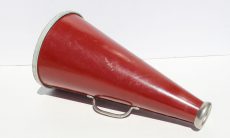The bottom line for any content marketing is getting your audience to take action. Ideally, your goal is to strengthen the relationship you are building with them and move them toward becoming a client.
That action can be anything from downloading a white paper or report, to signing up for your email newsletter, to requesting a product demo, to picking up the phone and calling for more information.
The mechanism we use to get this action to happen is frequently referred to as a “call to action” or CTA.
CTAs are frequently talked about purely from a design standpoint: how big is the button that says “Buy Now,” and what color is it? And while design is certainly an important part of effective CTAs, we’re going to look at them more broadly. Let’s start with design, though, as that’s the easiest point of entry and helps set up the other aspects of solid CTA execution.
Visual Design for CTAs
It should be fairly obvious that creating an effective CTA is all about making that CTA stand out from the content around it. That’s typically done with size, color, font/design treatment, page placement, and white space.
First, size does matter. Too small doesn’t work, of course, but neither does too large. The CTA then begins to look more like a design element than a button that can be clicked.
For color and font/design treatment, the watchword is “contrast.” As we noted at the start, we want our CTAs to stand out and demand attention.
As you’d expect, page placement matters too. This is where a good designer can earn his or hear keep in no time. Which isn’t to say that good placement is fast or easy. It’s just that the value of good placement is tremendously high and placement is typically a quicker problem to solve than full-scale site design or even landing page design. Frequently, effective placement breaks the patterns created by the page layouts overall. Again, the goal is to make the CTA stand out and, as with other design aspects, the trick is in doing so harmoniously.
It’s no accident that I’ve been light on specifics above. That’s because there really are no set rules. The only way to know if a CTA works visually is to test it. Even seasoned marketers get it wrong more than occasionally. (If you doubt the public’s ability to confound, look no further than, say, Ishtar, or any other big-budget Hollywood flop.) We’ll discuss testing in a bit more detail below.
Offer Design
The most beautifully designed CTA buttons in the world aren’t going to perform well if what you’re offering your audience is a swift kick in the pants. (We’ll set aside the fact that there are, I’m sure, businesses that cater to just such desires …)
Your offer has to have value on two levels: first, you have to make the offer attractive enough to get your audience to engage. Second, the offer has to relate to your marketing goals in ways that move prospects through the buying cycle. (You weren’t just interested in piling up great click-through rates, were you? You wanted to see some actual revenue for your efforts.)
It’s helpful to think of your offerings – and your CTAs – not as requests for your audience to share their email address or to pick up the phone and call you, but as requests for a bit of their attention. One is far more valuable than the other.
Great offers include things that bring your primary benefits to mind, that offer a taste of what your product or service will provide, or that reminds them that there’s a cost to doing nothing.
Plan B
Depending on where any particular prospect is in their decision-making process, he or she may need a second option. If they don’t yet know enough about you (or even your industry as a whole) they may not need that in-depth comparison you’re offering.
Instead of losing them completely, create an opportunity to move them along the funnel with more basic information.
Test, Test, and Test Again
Finally, remember that testing – particularly A/B testing – must be a part of your CTA creation plan. Focus groups and experience and even gut instinct can point you in the right direction, but until you put your landing page and CTAs out in the wild, you won’t know whether they’ll work well – or if they can be improved.




